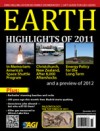 The magma that rises from the mantle, forming new islands, may blast more than it bubbles. Where those plumes of magma originate — at the core-mantle boundary or the mantle-crust boundary — and how fast they rise to the surface are still open questions among volcanologists. But now a new study of minerals from the volcano Mauna Loa on the Big Island of Hawaii suggests that some elements made a 2,900-kilometer-long journey from the core-mantle boundary to Earth’s surface in as little as half a million years — quadruple the speed found by previous studies.
The magma that rises from the mantle, forming new islands, may blast more than it bubbles. Where those plumes of magma originate — at the core-mantle boundary or the mantle-crust boundary — and how fast they rise to the surface are still open questions among volcanologists. But now a new study of minerals from the volcano Mauna Loa on the Big Island of Hawaii suggests that some elements made a 2,900-kilometer-long journey from the core-mantle boundary to Earth’s surface in as little as half a million years — quadruple the speed found by previous studies.
Alexander Sobolev, a geochemist at Joseph Fourier University in France, and his colleagues examined hundreds of miniscule inclusions in tiny grains of olivine in basaltic lava erupted from Mauna Loa. By measuring the amount of rubidium, which decays into strontium at a predictable pace, and the amount of strontium in the samples, Sobolev and his team concluded that there was too much strontium, given previously assumed mantle recycling rates.
The rubidium-strontium ratio is “the opposite of what you’d expect” for rocks formed from subducting seafloor only, says geochemist Tim Elliott of Bristol University of England, who was not part of the research team. So the strontium is likely from seawater, instead: As oceanic crust is subducted into the mantle, it brings seawater with it. Researchers know how strontium levels have changed in seawater over the Earth’s history, so once Sobolev and colleagues decided to assume that their strontium came from seawater, the age of the samples could be extracted from tables showing the concentration of strontium in seawater of different ages.
The strontium concentrations indicated an age of between 650 million and 200 million years, they reported in Nature. Assuming that the samples must have risen from the core-mantle boundary, which is much deeper than the 600-kilometer mantle-crust boundary, the scientists calculated a crustal recycling rate of between 1 and 3 centimeters a year, four times faster than what other research has suggested.
“It’s provocative and it’s an important break-through if it turns out to be confirmed,” says Dominique Weis of the University of British Columbia in Canada. “What’s exciting is that it’s proof that something that was near the surface went into the mantle and was then brought back up,” Weis says, adding that she would like to see more evidence of the timing of the cycle.
Weis and Elliott both say they’d like further proof of the faster recycling rate through examples from elsewhere in Hawaii or from other volcanic islands. “Mauna Loa is special,” Weis says. Lead isotopes have also shown anomalies on that volcano. “What I think should be done is to do analysis of more lava from other volcanoes,” she adds. Indeed, Sobolev’s “model would predict it’s a common occurrence,” Elliott says, so it should be possible to test the model by collecting and analyzing more samples elsewhere.
See this news story as it appeared in EARTH Magazine: [pdf]